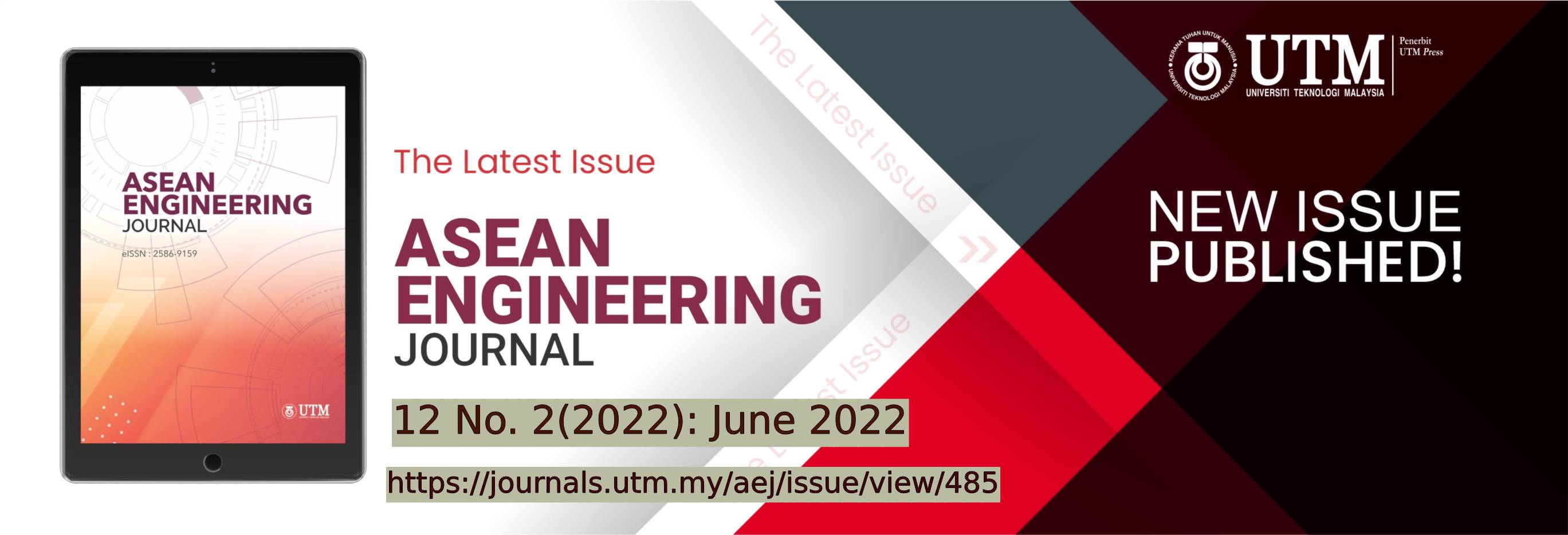MATHEMATICAL MODELING WITH PARAMETER IDENTIFICATION FOR HEXAROTOR SYSTEM: A HAMILTONIAN APPROACH
DOI:
https://doi.org/10.11113/aej.v12.17188Keywords:
Hamiltonian Approach, Hexarotor System, Mathematical Modelling, Parameter Identification, Unmanned Aerial Vehicle (UAV)Abstract
This paper presents a mathematical modeling with parameters identification of Unmanned Aerial Vehicle (UAV) system or hexarotor system using the Hamiltonian approach. The mathematical model of the hexarotor is derived from the Hamiltonian approach which involved the storage, dissipation, and routing of energy elements from the UAV. This UAV model parameters identification method is proposed as an alternative to the commonly used wind tunnel testing, which is complex and tedious. This Hamiltonian model is made of a fully actuated subsystem with roll, pitch, and yaw angles as output, as well as an under-actuated subsystem with position coordinates as its output. Thrust constant, drag constant and speed of hexarotor are determined through the experimental setup while moment of inertia is determined by physical measurement and calculation. The outcome from this research works demonstrates an undemanding, yet effective method of modeling an UAV, and is useful for designing nonlinear controller to perform the important UAV tasks such as taking off, hovering, and landing.
References
Y. Wu, K. Hu, and X. M. Sun, 2018. Modeling and control design for quadrotors: A controlled hamiltonian systems approach. IEEE Transactions on Vehicular Technology. 67(12): 11365-11376 DOI: https://doi.org/10.1109/TVT.2018.2877440
M. Moussid, A. Sayouti, and H. Medromi. 2015. Dynamic Modeling and Control of a HexaRotor using Linear and Nonlinear Methods. Int. Journal of Applied Information System. 9(5) :9-17. DOI: https://doi.org/10.5120/ijais2015451411
H. Liu, D. Derawi, J. Kim, and Y. Zhong. 2013. Robust optimal attitude control of hexarotor robotic vehicles. Nonlinear Dynamic. 74(4) : 1155-1168. DOI: https://doi.org/10.1007/s11071-013-1031-4
K. Hu, Y. Wu, and X. M. Sun. 2017. Attitude controller design for quadrotors based on the controlled Hamiltonian system. Proc. 29th Chinese Control Decision Conf. CCDC 2017, 5137-5141. DOI: https://doi.org/10.1109/CCDC.2017.7979407
V. Artale, C. L. R. Milazzo, and A. Ricciardello. 2013. Mathematical Modeling of Hexacopter Reference systems for the hexacopter. Applied Mathematical. Science. 7(97): 4805-4811. DOI: https://doi.org/10.12988/ams.2013.37385
D. Derawi, N. Dayana Salim, M. Azizi, A. Rahman, S. A. Mazlan, and H. Zamzuri. 2014. Modeling, attitude estimation, and control of Hexarotor micro aerial vehicle (MAV). Proc. IEEE Int. Conf. Ind. Technol. 55-60. DOI: https://doi.org/10.1109/ICIT.2014.6894972
H. Liu, D. Derawi, J. Kim, and Y. Zhong. 2013. Robust optimal attitude control of hexarotor robotic vehicles. Nonlinear Dynamic 74. 1155–1168. DOI: https://doi.org/10.1007/s11071-013-1031-4
C. Souza, G. V. Raffo, and E. B. Castelan. 2014. Passivity based control of a quadrotor UAV. IFAC Proceeding Volumes. 19(3): 3196-3201. DOI: https://doi.org/10.3182/20140824-6-ZA-1003.02335
H. Ramirez, B. Maschke, and D. Sbarbaro. 2013. Modelling and control of multi-energy systems: An irreversible port-Hamiltonian approach. European Journal of Control. 19(6):513-520. DOI: https://doi.org/10.1016/j.ejcon.2013.09.009
X. Wang and L. Cai. 2015. Mathematical modeling and control of a tilt-rotor aircraft. Aerospace Science and Technology. 47:473-492. DOI: https://doi.org/10.1016/j.ast.2015.10.012
T. Module. 2016. ARDU 2001 Arduino-based Navigation System for Small-scale Aerial Robot 1.
R. Rashad, F. Califano, and S. Stramigioli. 2019. Port-Hamiltonian Passivity-Based Control on SE(3) of a Fully Actuated UAV for Aerial Physical Interaction Near-Hovering. IEEE Robotic and Automation Letters, 4(4): 4378-4385. DOI: https://doi.org/10.1109/LRA.2019.2932864
Alaimo, Andrea & Artale, V. & Milazzo, C. & Ricciardello, Angela. (2014). PID Controller Applied to Hexacopter Flight. Journal of Intelligent and Robotic Systems. 73: 261-270. DOI: https://doi.org/10.1007/s10846-013-9947-y.
D.-K. Le and T.-K. Nam. 2015. A study on the modeling of a hexacopter. Journal of the Korean Society of Marine Engineering. 39 (10):1023-1030. DOI: https://doi.org/10.5916/jkosme.2015.39.10.1023
T. Hamel, R. Mahony, R. Lozano, and J. Ostrowski. 2002. Dynamic modelling and configuration stabilization for an X4-flyer. IFAC Proceeding Volumes. 15(1): 217-222 DOI: https://doi.org/10.3182/20020721-6-ES-1901.00848
A. Chovancová, T. Fico, E. Chovanec, and P. Hubinský. 2014. Mathematical modelling and parameter identification of quadrotor (a survey). Procedia Engineering. 96:172-181. DOI: https://doi.org/10.1016/j.proeng.2014.12.139
Abas, N., Legowo, A., Ibrahim, Z., Rahim, N., & Kassim, A. M. 2013. Modeling and system identification using extended kalman filter for a quadrotor system. Applied Mechanics and Materials. 313-314:976-981. DOI: https://doi.org/10.4028/www.scientific.net/amm.313-314.976
M. Ryll, H. H. Bülthoff and P. R. Giordano. 2015. A Novel Overactuated Quadrotor Unmanned Aerial Vehicle: Modeling, Control, and Experimental Validation. IEEE Transactions on Control Systems Technology 23(2):540-556. DOI: https://doi.org/10.1109/TCST.2014.2330999.
















